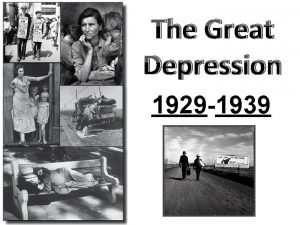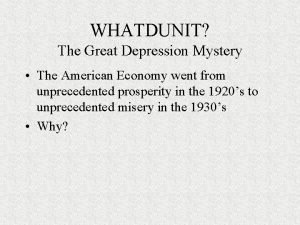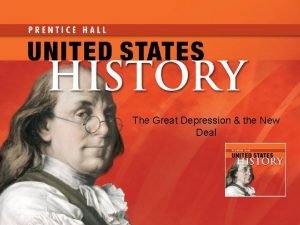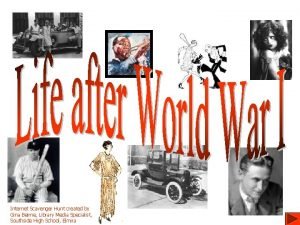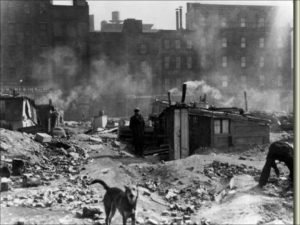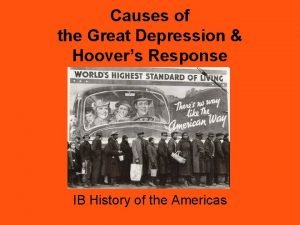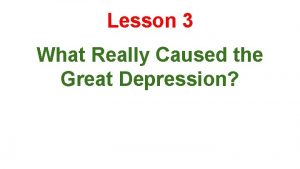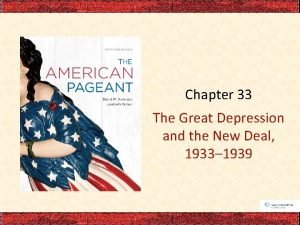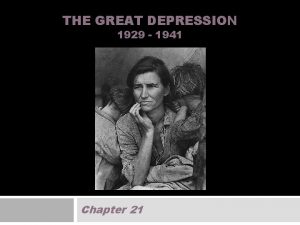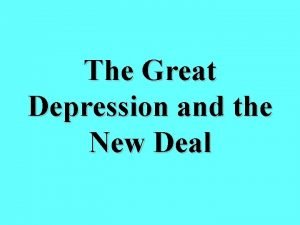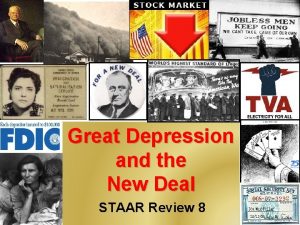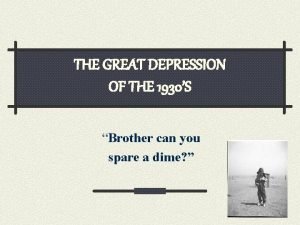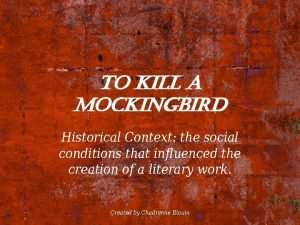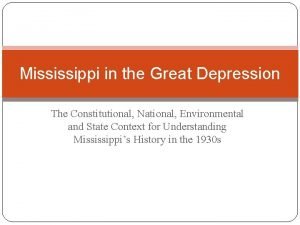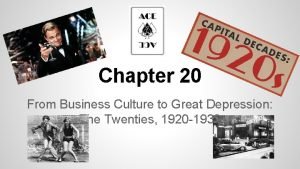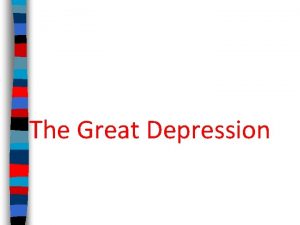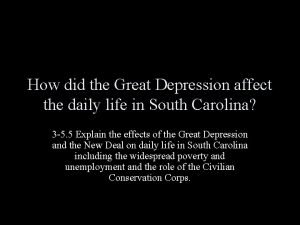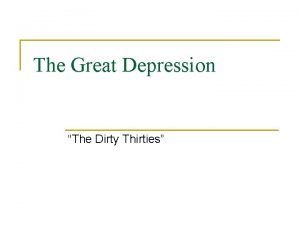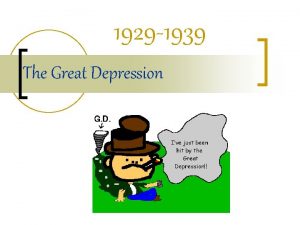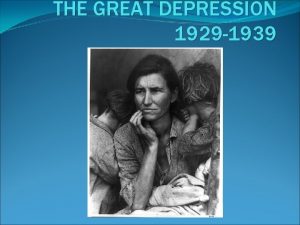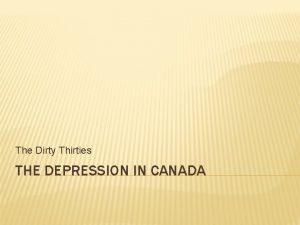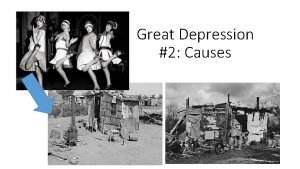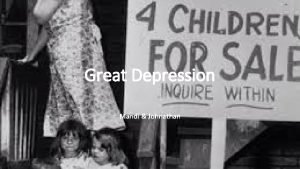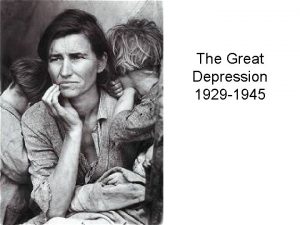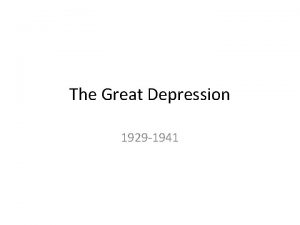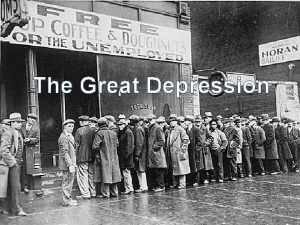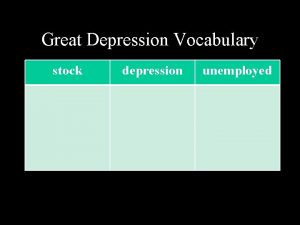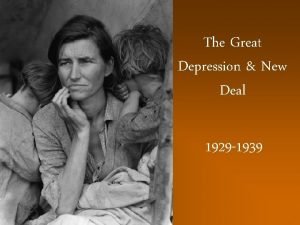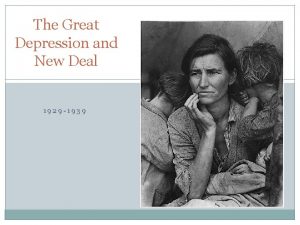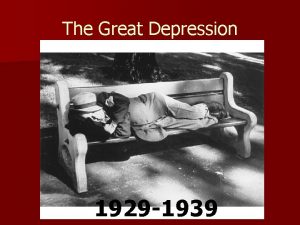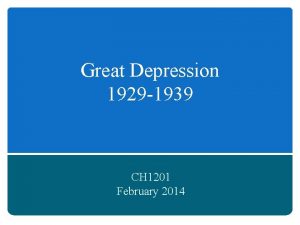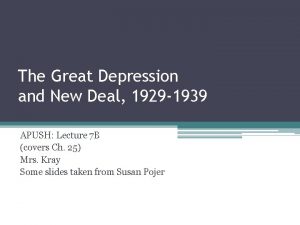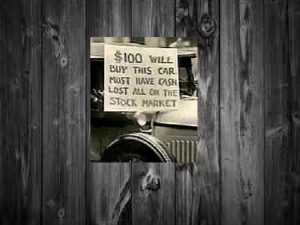THE GREAT DEPRESSION THE DIRTY THIRTIES 1929 1939



























- Slides: 27

THE GREAT DEPRESSION & THE DIRTY THIRTIES 1929 -1939

THE END OF THE GOOD TIMES – STOCK MARKET CRASH As the 1920 s ended so did the prosperity and good times. On October 29 th, 1929, a date known as “Black Tuesday” the New York Stock Market crashed. Because Canada and the USA are so closely connected economically and socially, we too felt the crash in a major way.

WHAT IS A STOCK MARKET? The stock market is an everyday term we use to talk about a place where stocks and bonds are "traded" – meaning bought and sold. For many people, that is the first thing that comes to mind for investing. The goal is to buy the stock, hold it for a time, and then sell the stock for more than you paid for it.

A DEEPER UNDERSTANDING To get a better understanding of the Stock Market take a look at the Understanding the Stock Market section found on pg 96 in the text book. Video – Stock Market for Dummies

JUST A PIECE OF THE PUZZLE While the stock market crash did seem to play a large role in the onset of the Great Depression it wasn’t the only factor that led to this deep, longest-lasting economic downturn in the history of the Western industrialized world.

PRIOR KNOWLEDGE What have we learned about so far that may have played a factor in this crash? Ø Debt and Credit Ø False Expectations of Investing Ø Increased Production and the Struggle for Demand to Keep Up

DEBT AND CREDIT In the 1920 s, there was a rapid growth in bank credit and loans in the US. Encouraged by the strength of the economy, people felt the stock market was a sure bet. Some consumers borrowed to buy shares. Firms took out more loans for expansion. As we had learned people were used to spending and borrowing and….

HOW DOES THIS MAN FEEL ABOUT SELLING HIS CAR? WHY?

FALSE EXPECTATIONS OF INVESTING A lot of the stock market crash can be blamed on high and false expectations. In the years leading up to 1929, the stock market offered the potential for making huge gains in wealth. It was the new gold rush with relatively no risk. People bought shares with the expectations of making more money. As share prices rose, people started to borrow money to invest in the stock market as they were convinced that it was a good investment.

TOO MUCH OF A GOOD THING The 1920 s saw great strides in production techniques, especially in industries like automobiles. The production line enable great increases in production. However, demand for buying expensive cars and consumer goods were struggling to keep up. Therefore, towards the end of the 1920 s many firms were struggling to sell all their production.

INCREASED PRODUCTION AND THE STRUGGLE FOR DEMAND TO KEEP UP The agricultural sector was struggling to maintain profitability. Many small farmers were driven out of business because they could not compete with larger farms. Better technology was increasing supply, but demand for food was not increasing at the same rate. Therefore, prices fell and farmers incomes dropped and many struggled to remain profitable. Surpluses of goods piled up in warehouses and farmers continued to grow wheat even when the demand peaked in 1927. ($1. 03 > $0. 29)

THE STOCK MARKET CRASH OF 1929 On October 29, 1929, Black Tuesday hit Wall Street as investors traded some 16 million shares on the New York Stock Exchange in a single day. Billions of dollars were lost, wiping out thousands of investors. Investors were frantically trying to sell their shares as soon as possible so they wouldn’t lose all of their money but as the fear spread it was too late for many and market continued to plummet.

CANADA AND THE USA AND THE WORLD With our close trading ties Canada and the USA both suffered from this economic collapse. As the American economy slowed so did their interest in Canadian imports. American companies began to pull out of Canada and branch plants closed down. Thousands and thousands of people lost their jobs and this again multiplied the problems that Canada faced. By 1932, international trade dropped by 50% from its heights in the 1920 s and many countries increased tariffs on imports.

THE BANKS AND OTHER BUSINESSES Financial institutions were not safe from the economic crisis, and although Canada wasn’t hit as hard as the USA we still experienced great losses. People’s saving accounts were lost as banks went out of business. Companies that managed to stay open were forced to lay off workers in order to stay afloat. This increased unemployment further compounded the problems faced by banks because unemployed workers couldn’t pay off their debt.


THE GREAT DEPRESSION IN CANADA The worldwide Great Depression of the early 1930 s was a social and economic shock that left millions of Canadians unemployed, hungry and often homeless. Few countries were affected as severely as Canada during what became known as the Dirty Thirties, due to Canada’s heavy dependence on raw material and farm exports, combined with a crippling Prairies drought.

PRAIRIE DROUGHT IN SASKATCHEWAN IN THE LATE 1920 S

WRITING ACTIVITY Using the knowledge about the “Roaring 20 s” and the “Dirty 30 s” write about the Historical Significance of knowing about this time period. Also, write about examples of Cause and Consequences of “Black Tuesday”. This mini-assignment will be able to used as evidence of your understanding for our upcoming conferences.

EFFECTS OF THE GREAT DEPRESSION In 1929, Liberal William Lyon Mackenzie King was the prime minister of Canada. He and thousands of other Canadians thought the Depression was a temporary set back that would end quickly, they were wrong. In 1930 King and his Liberal party lost the federal election to Conservative leader R. B. Bennett.

FAILING ECONOMIC POLICIES During his campaign Bennett had promised to take action to stop the downward economic spiral. Bennett’s government gave $20 million in aid to the provinces. This money was used for public relief (welfare) and public works projects. These projects included building roads and bridges and other activities that were designed to get people back to work.

The “Bennett Buggy” was a term used in Canada during the Great Depression to describe a car which had its engine and windows taken out and was pulled by a horse.

While the make-work projects seem to help some people Bennett wasn’t able to negotiate better tariffs with the US and Britain. Bennett then attempted to balance the financial budget as was done in the past when times were tough but that didn’t help as conditions got worse. Some economists believe that if Bennett has spent more money he could have helped Canada recover quickly. Why would they think this?

SOCIAL CONCERNS Unemployment ruined lives during the Great Depression. Unskilled workers, labourers, smallbusiness owners, farmers, and young people found it nearly impossible to find work. Lives worsened for the already disadvantaged such as the poor, working women, First Nations, and visible minorities. These groups experienced discrimination when looking for work, and many lost the jobs they already had.

HARD TIMES Luxuries and “extras” vanished except for the wealthy. For many, essential vanished and many people were homeless and hungry. Malnutrition and diet-related diseases such as scurvy became all too common. Keep in mind that in the 30 s there was no government assistance programs like medicare, employment insurance or child tax credits.

Those how lost jobs had to suffer the embarrassment of asking for public relief, also know as “the dole” or “pogey. ” This was the last option for many and was humiliating for many who had ran out of options. Those who had to seek pogey had to give up drinking alcohol as well as their driver’s license and relief camps were set up to house young men in this desperate time. Many of the homeless became hobos and “rode the rails” looking for work across Canada.

“RIDING THE RAILS” How do you think these hobos were treated in the communities they traveled to?

VIEWING AND WRITING ACTIVITY Read the Primary Source stories on page 98 -99 and answer the questions found in Figure 6. 14 and Figure 6. 15
 Rrr great depression
Rrr great depression Stock market great depression political cartoon
Stock market great depression political cartoon Black tuesday political cartoon
Black tuesday political cartoon Great depression vocabulary jeopardy
Great depression vocabulary jeopardy Overspeculation great depression
Overspeculation great depression The ingenious quarterback analysis
The ingenious quarterback analysis Five effects of the great depression
Five effects of the great depression Hoover's response to the great depression
Hoover's response to the great depression What was hoover's response to the great depression
What was hoover's response to the great depression Great depression political cartoons
Great depression political cartoons How did the great depression impact the world
How did the great depression impact the world Lesson 3 effects of the great depression
Lesson 3 effects of the great depression Chapter 33 the great depression and the new deal
Chapter 33 the great depression and the new deal Http://www.history.com/topics/great-depression
Http://www.history.com/topics/great-depression Vocabulary review causes of the depression
Vocabulary review causes of the depression Hawley smoot tariff apush
Hawley smoot tariff apush Mexican repatriation apush
Mexican repatriation apush Dust bowl map
Dust bowl map Cpi during the great depression
Cpi during the great depression Social context of to kill a mockingbird
Social context of to kill a mockingbird Great depression
Great depression The great depression summary
The great depression summary From business culture to great depression
From business culture to great depression Ww1 to great depression cloze notes
Ww1 to great depression cloze notes Great depression vocab
Great depression vocab Foreclosure great depression
Foreclosure great depression The great depression outline
The great depression outline How did the great depression affect daily life
How did the great depression affect daily life
